Do you want to learn about Large Bees in Louisiana?
Finding a Guide to Large Bees in Louisiana was not as easy as I thought. There are lots of bees in Louisiana and some of the guides were too broad, others were irrelevant, and some didn’t provide enough information.
That’s why I created a list of the 10 Large Bees in Louisiana.
This ultimate guide will not only give you large bees in Louisiana but also important and interesting facts about them.
10 Large Bees in Louisiana
#1. Honey Bee (Apis mellifera)

Identifying Characteristics and Facts
- About 12 – 15 mm in length.
- Yellow with dark brown bands on the abdomen.
- They live in organized colonies, mostly in the hives.
- Colonies comprise the workers, drones, and the queen.
- Have compound eyes and two pairs of wings.
- Only female bees have a stinger.

As the name indicates, honey bees are known for their honey production. They do this by collecting nectar from flowers of different plants, then using it to make honey.
If you look at Louisiana Gardens and Flowers you are bound to find honey bees. They love moving from one plant to another in search of nectar and are great pollinators. This is critical for better gardens, fruiting trees, and other plants.
Not only that, but one of the best parts of honey bees is the honey they produce. Most of the time, they are kept by farmers in hives for the production of honey and can be found almost anywhere in the world.
#2. Leaf-cutting bee (Megachile spp)
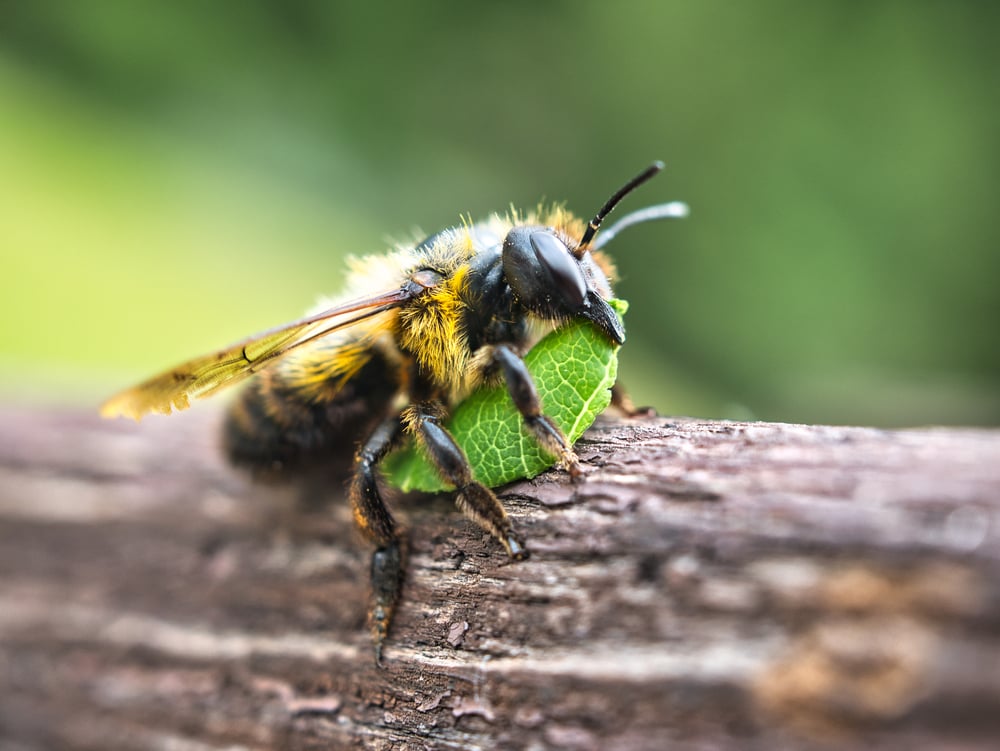
Identifying Characteristics and Facts
- Medium-sized and between 8 – 20 mm in length.
- Have strong mandibles for cutting the leaves and have bodies covered with dense hairs.
- Have varying colors including metallic green to reddish-brown among other colors.
- Are solitary and do not live in colonies.
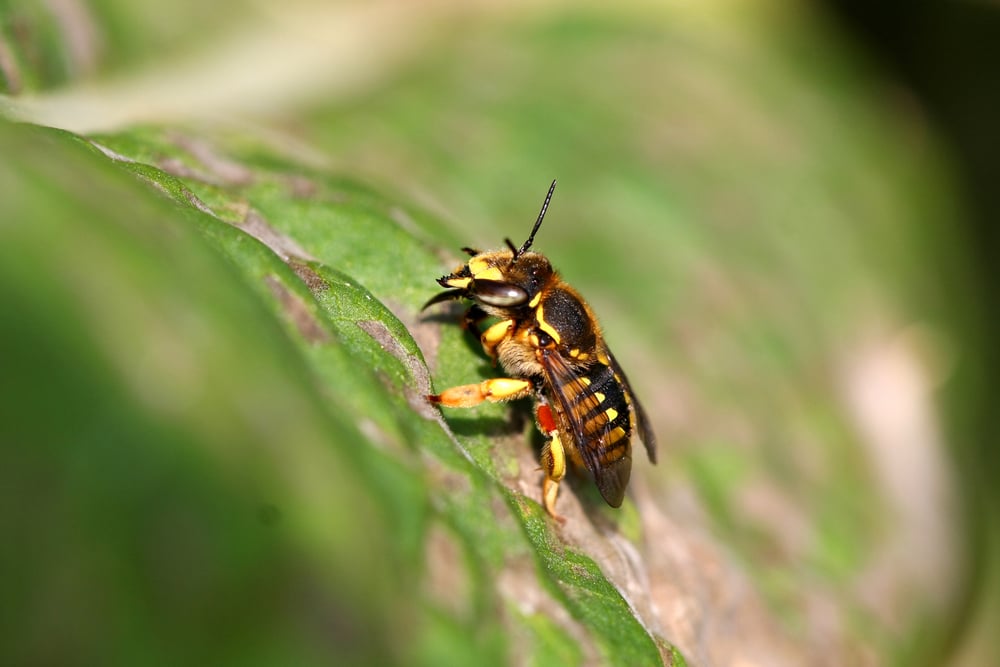
These are the type of bees that are common in Louisiana and known for cutting and transporting leaves. Their cuts are neat and circular and you can easily identify them from the leaves they destroy. They use the leaves cut to primarily construct their cells.
Unlike honey bees, leaf-cutting bees do not live in colonies. They live individually in their nests, or hollow plant stems. When you see a leaf-cutting bee it is not unusual to see only one at a time.
Regardless of whether or not they live in colonies, these are important pollination agents. While cutting the leaves that they use for their nests, they can carry pollen on their hairy bodies to the next plant flowers.
#3. Bumble bee (Bombus spp)
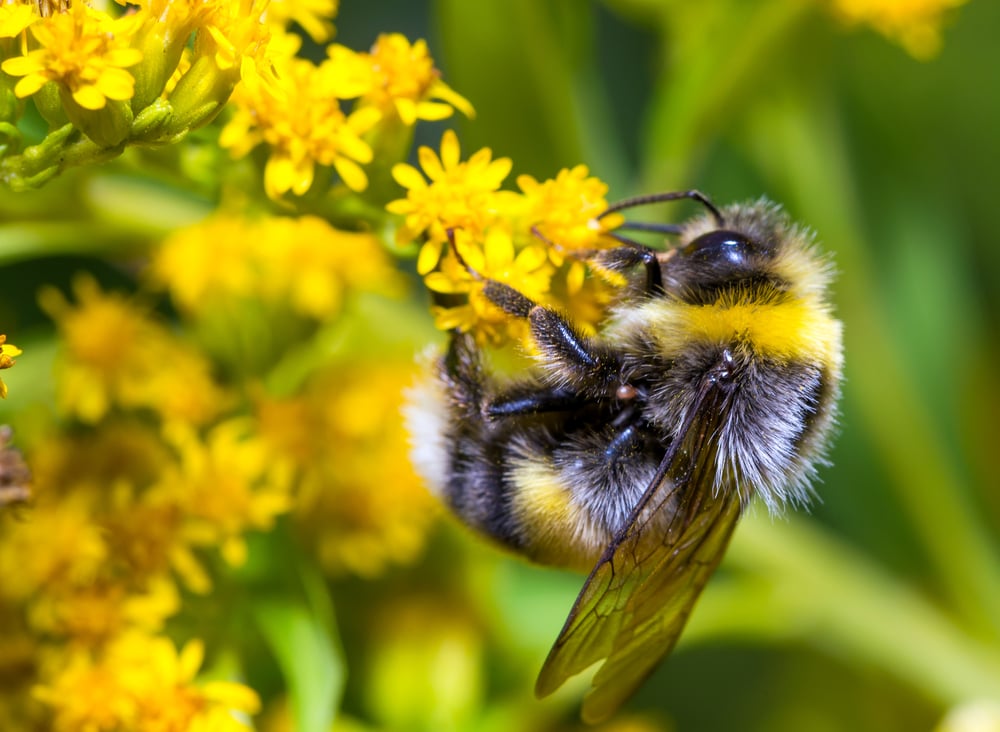
Identifying Characteristics and Facts
- Have robust and hairy bodies.
- About 1.7 – 2.0 cm in length.
- Vary in color with some showing yellow, black, orange, or red bands.
- Are social insects and hence live in colonies.
- They nest underground.
- They are strong fliers even in extreme weather conditions.

Bumblebees are social insects that you can always find in Louisiana. They have a queen that lays eggs, female workers, and males or drones.
One thing you will note about the bumblebees is their buzz nature. They vibrate while on the flower and hence are great pollinators. They do this so that they are able to extract pollen grains with ease.
It is also worth for you to note that these bees are most active during summer and spring. Therefore, you will find them with ease during this season. Not only this, but you’ll also be able to tell this type of bee by how much bigger it is than other bees!
#4. Sweat bee (Halictidae spp)
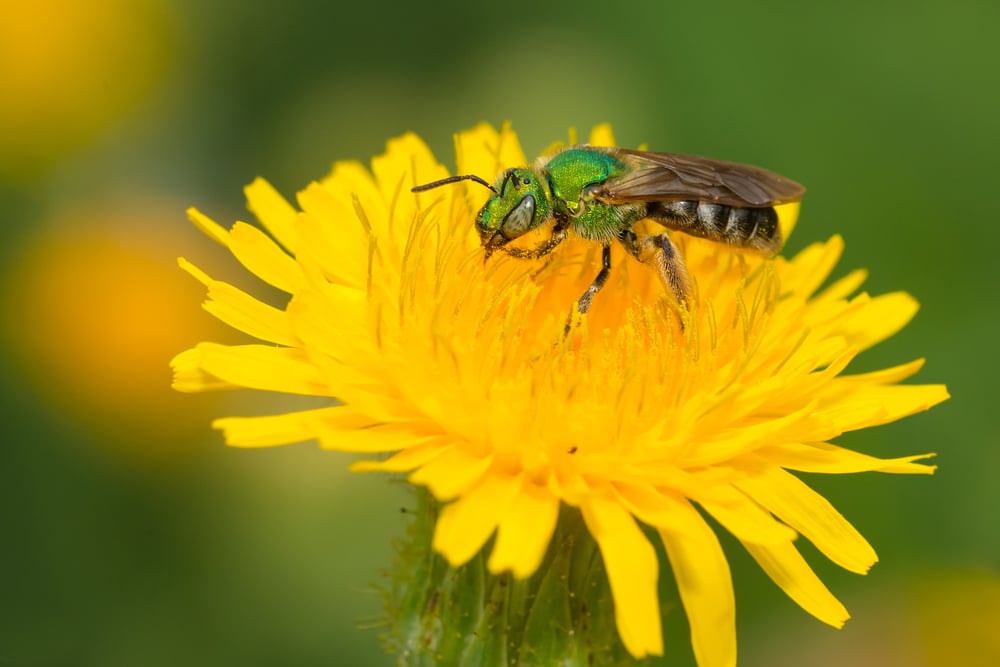
Identifying Characteristics and Facts
- About 0.08 – 0.6 inches long.
- They are of different colors but always have a green head
- Not aggressive and stings only when threatened.
- Live in different habitats including dead wood or underground burrows.
- Elongated slender body shape.
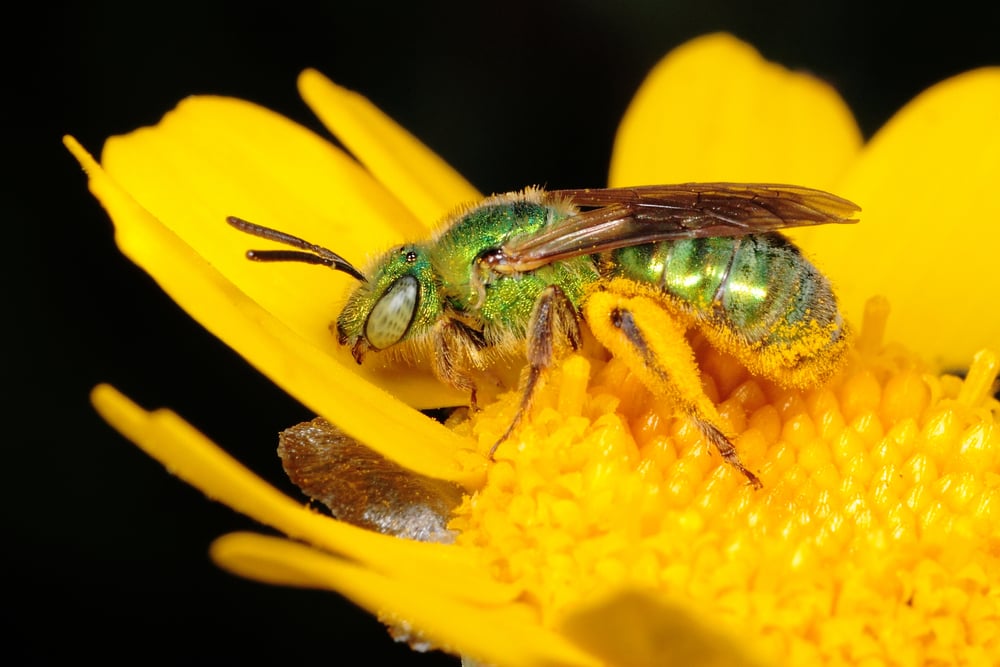
These are common bees that you will not only find in Louisiana but across the world. As the name puts it, they are called sweat bees because they have a high affinity to sweat out body fluids.
It is also important to note that sweat bees are also classified into different species. There are several species of these bees and each comes with their distinct characteristics.
Due to their diet and nature, you are likely to find them in bathrooms, gardens, or anywhere with human perspiration. This is because they are attracted by the salts and the moisture that is in the human fluids.
One common characteristic across the species of these bees is their docile nature or behavior. They are not aggressive and that means they do not sting. The rare time you would get stung by this is if you are perceived to be hostile or aggressive towards it.
#5. Large Carpenter bee (Xylocopa spp)
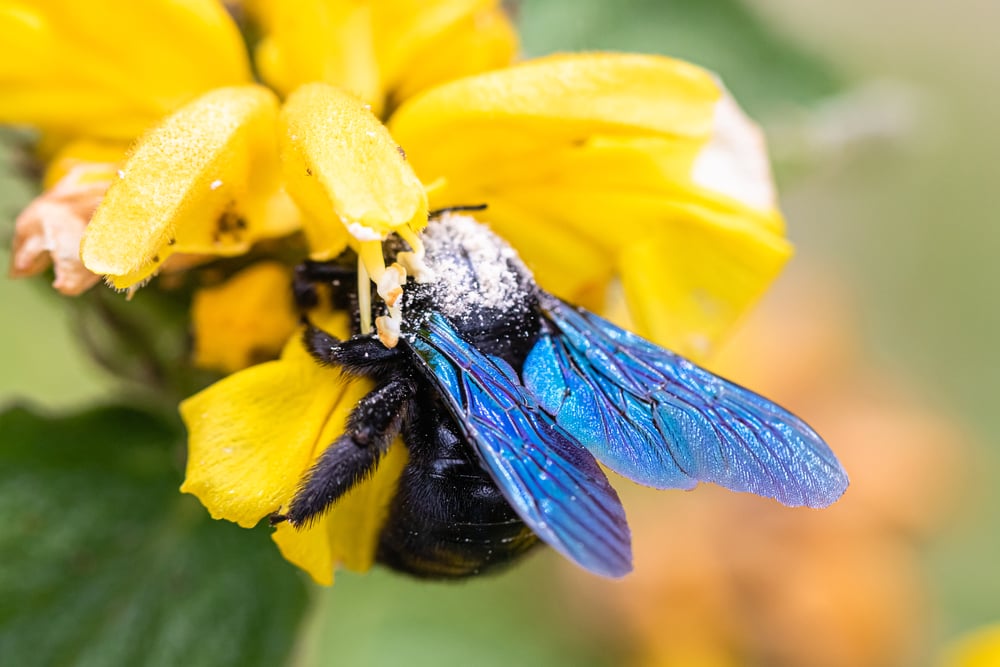
Identifying Characteristics and Facts
- About 19 – 23 mm in length.
- Black body covered with yellow hairs. Have robust and sturdy built bodies.
- Distinctive loud buzzing when in flight.
- They have solitary behavior.
- Excavates dead wood and wooden structures for nesting.
- The females have a stinger but are docile.
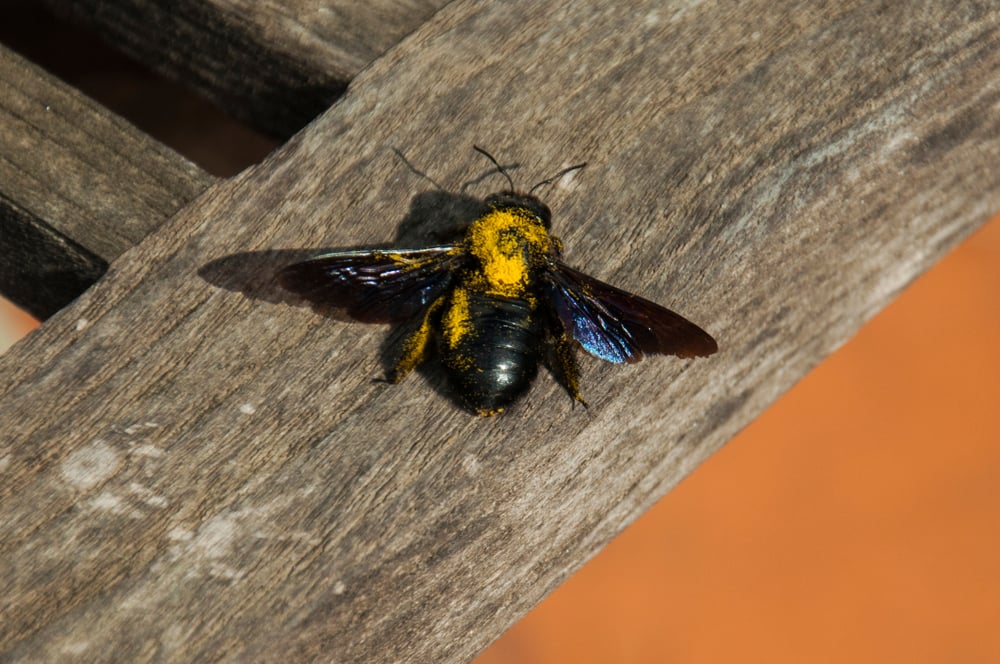
The large carpenter bee is one of the largest bees in Louisiana. Of course, it is not only the largest in Louisiana but is also one of the largest in the world.
It is one of the common bees in Louisiana known to excavate tunnels in dead woods for their nesting. Their habitat is mainly wooden structures but they live solitarily and not in colonies.
When it comes to their importance, large carpenter bees are great pollinators. These bees are more attracted to tubular-shaped flowers like the trumpet vines and this helps a lot in transferring pollen across these types of flowers.
Related: Useful Plants That Attract Bees to Your Garden
Comparing the female and male large carpenter bees, you will note that the females have the stinger while the males do not. Though this is the case, they are still docile and are less likely to sting unless provoked.
#6. Mason bee (Osmia spp)
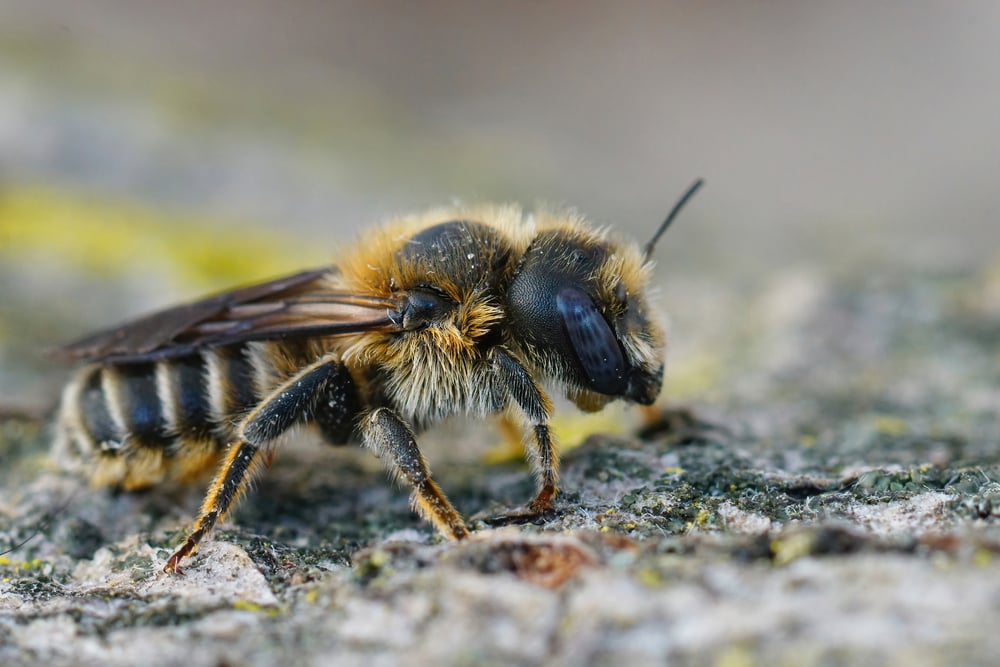
Identifying Characteristics and Facts
- Mid-sized and about 8 – 20 mm in length.
- They are solitary in nature and do not live in colonies.
- Docile and less aggressive to humans.
- They live in hollow plant stems where they build their partitioned brood cells.
- Active during the spring and early summer.
- Are in different colors such as metallic blue, green, and black.

Their masonry behavior is what gives this bee its name. They use chewed plant material or mud to build partitioned brood cells inside existing wood cavities.
While mason bees build brood cells inside existing wood cavities it should be noted that they are a solitary type of bee. They do not live in colonies like some other bees but generally display similar behavior.
It is important to note that these bees are not aggressive to humans but rather docile. They rarely sting and will avoid humans at all costs.
In addition to that, they are excellent pollinators. Just like other bees, this is an important ecological function that promotes reproduction in plants.
#7. Squash bee (Peponapis pruinose)
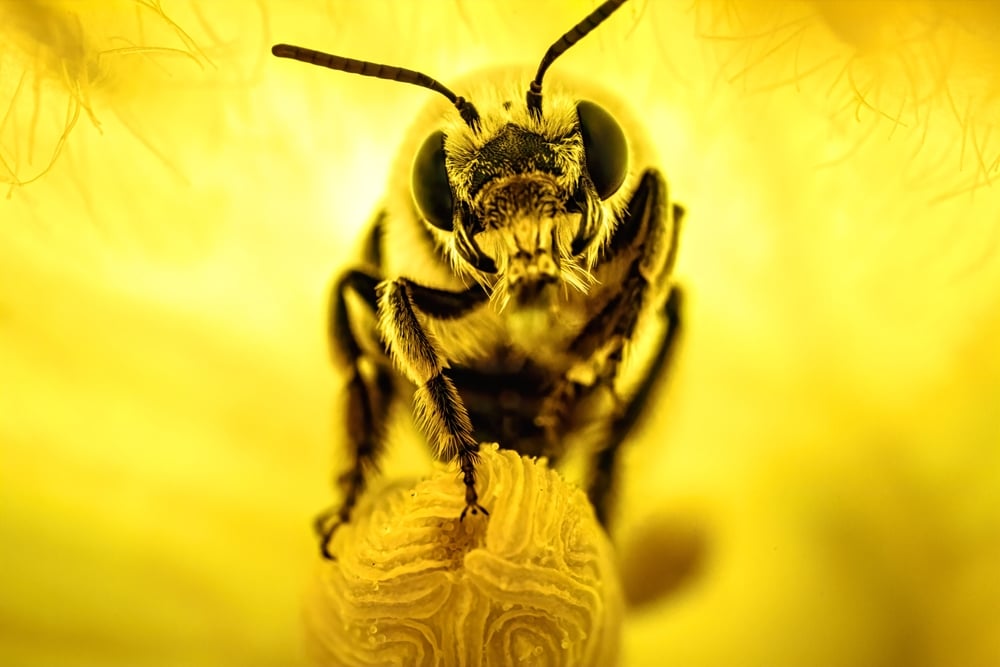
Identifying Characteristics and Facts
- About 11 – 14 mm in length.
- Brown body with light dense hairs.
- Hairs on rear legs for carrying pollen.
- They collect pollen through buzz pollination or sonication technique.
- Mostly active during summer months.
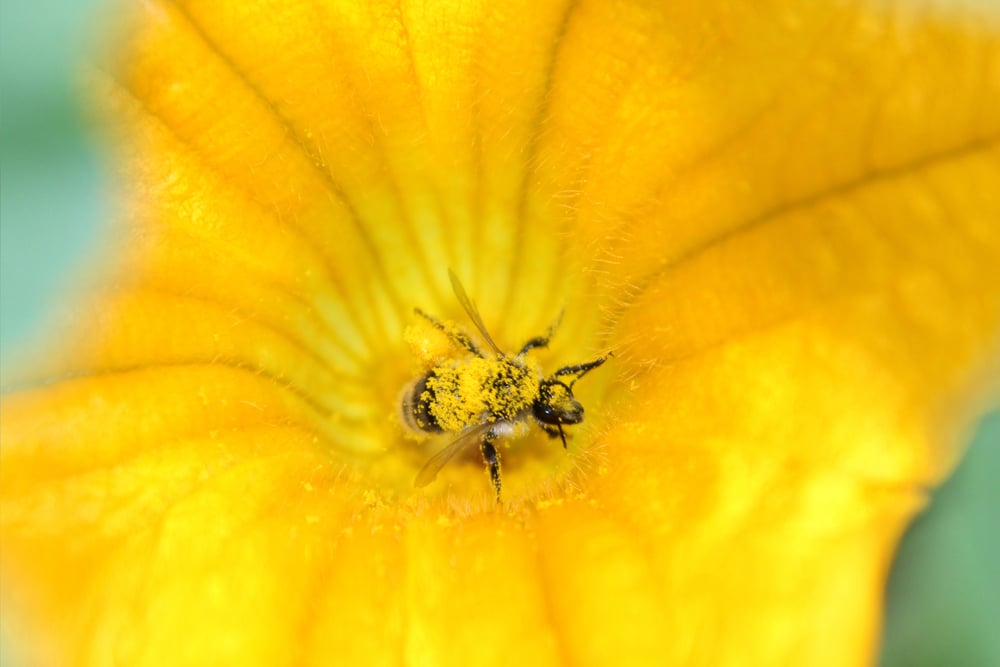
The reason why this type of bee is called squash bees is that they only collect pollen from the squash flowers. The squash bee is one of the common bees in Louisiana and is also common in other parts of the world.
To easily spot these bees, you will need to check the gardens that have Cucurbitaceae family plants cultivated. These include the squashes, pumpkins, and gourds.
These bees also nest in the ground where you will find the plants that they pollinate. They, therefore, play ecological importance in the pollination of these plants as well as reproduction.
It is also important to add that they are excellent pollinators. You will see them mostly during the warm months or seasons when there are squash blooms.
#8. Small carpenter bee (Ceratina spp)
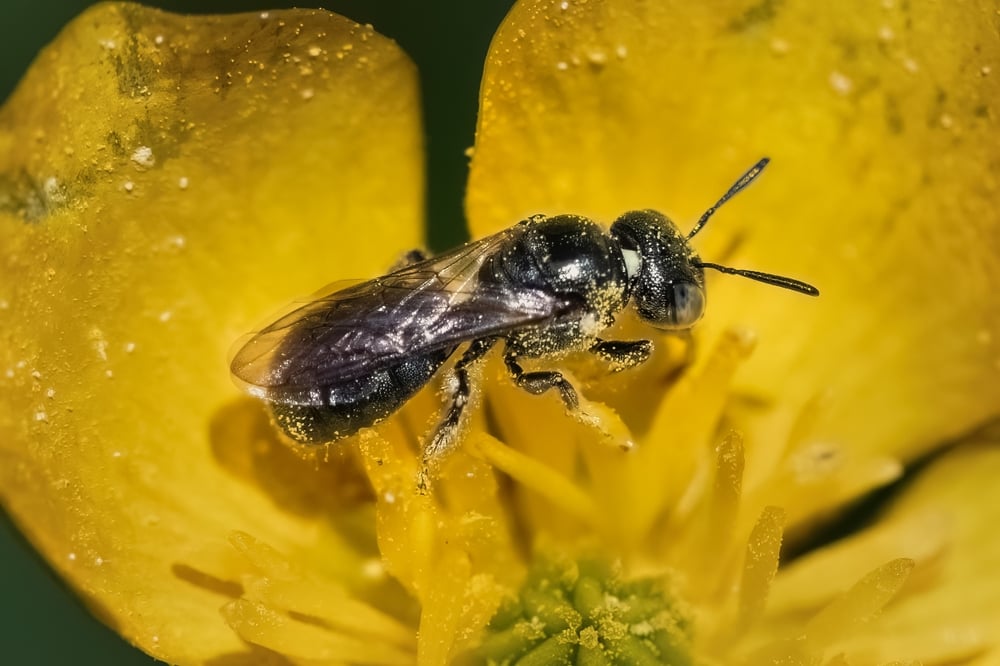
Identifying Characteristics and Facts
- About 5 – 8 mm in length.
- Have a shiny dark-blue-green appearance.
- Hairs on the rear legs for carrying pollen.
- Shield-shaped abdomen and slender body.
- Are solitary and they nest in stems and twigs.
- Have pale yellow markings on the face.
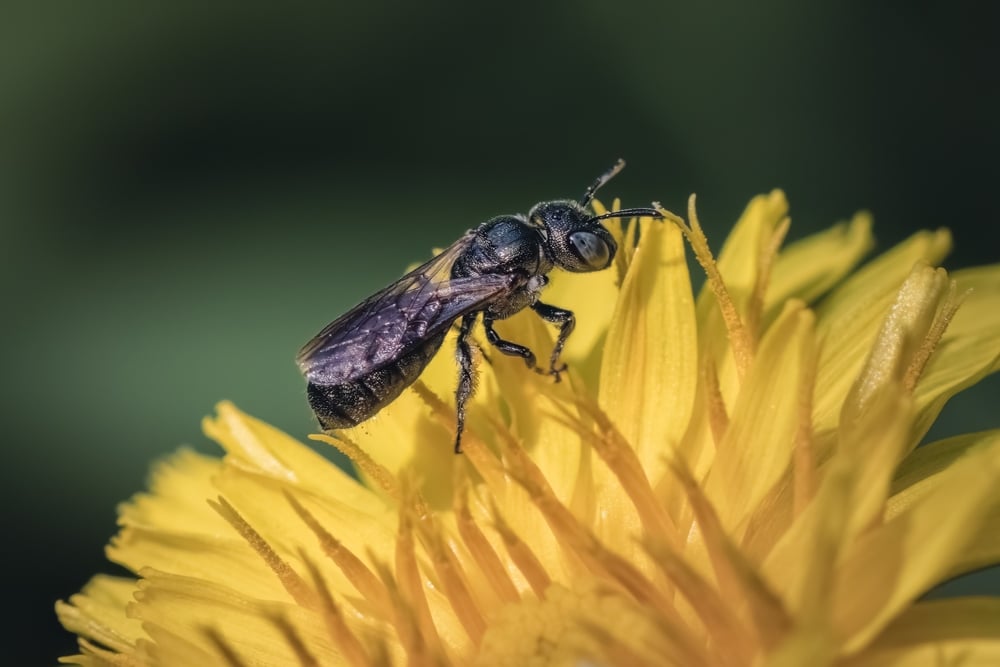
This is a smaller version of the large carpenter bees. They are important when it comes to promoting pollination in plants. As they move from one flower to another, they carry pollen in their bodies which is important in the reproduction process.
When it comes to aggressiveness, these bees are less aggressive than large carpenters. That means they are less likely to sting unless they feel threatened.
The most interesting thing about these bees is their nesting behavior. They can build their brood cells in different materials such as hollow twigs, old insect burrows, and plant stems. You should be extra careful during fall cleanup not to disturb small carpenter bees.
#9. Mining bee (Andrena spp)
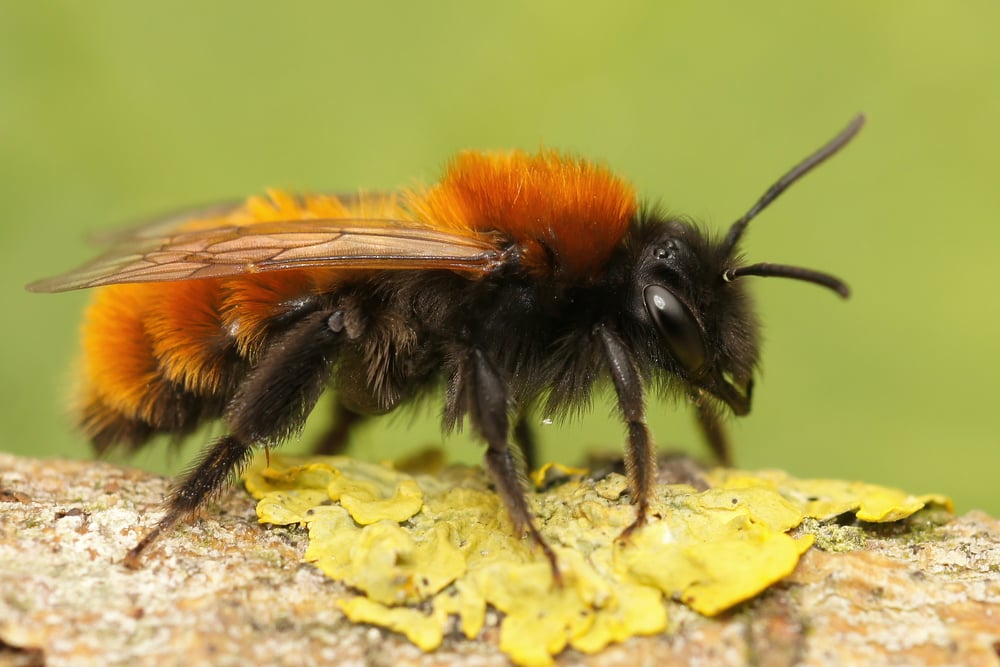
Identifying Characteristics and Facts
- They are less aggressive than large carpenter bees and do not sting.
- About 10 – 25 mm in length.
- Have stout and hairy bodies.
- Color varies but mostly black to shades of brown and red.
- Solitary and do not live in colonies.
- Plays an important role in pollination and reproduction in plants.
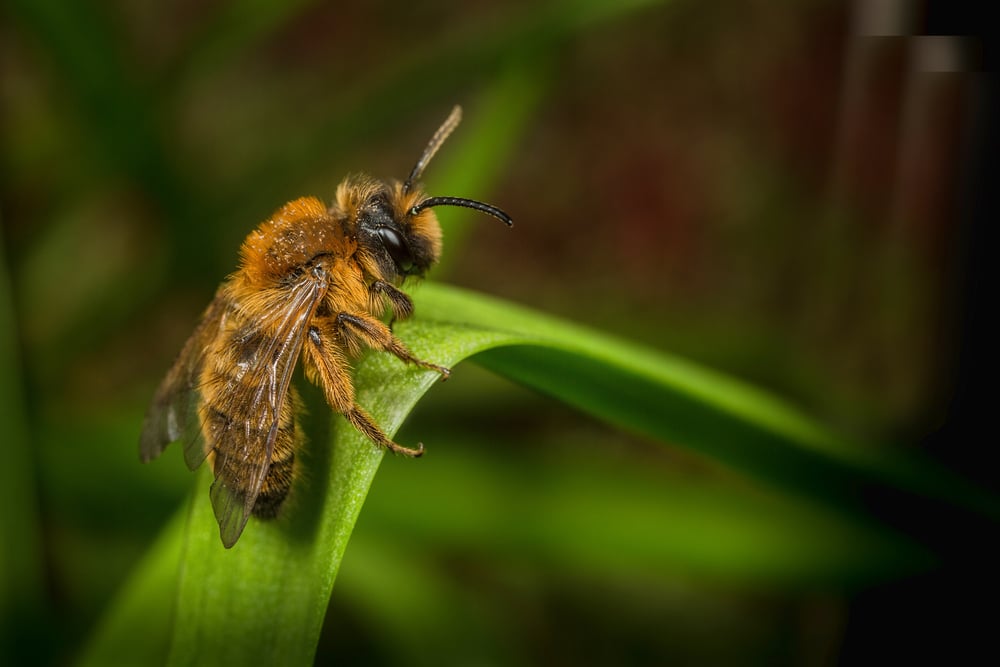
Mining bees are another type of solitary bee. That means they don’t live in colonies but rather in their own nests. These bees are common in Louisiana and as well as in many other parts of the world.
Mining bees are called this because of their nesting behavior. They excavate tunnels into the ground where they construct their nests. You will, therefore, likely find their nests in the meadows, lawns, and gardens among other open areas.
It is also worth for you to note that mining bees are seasonal. That means they are only active during summer and spring. They are also non-aggressive and do not sting.
#10. Long-Horned Bees (Melissods spp)
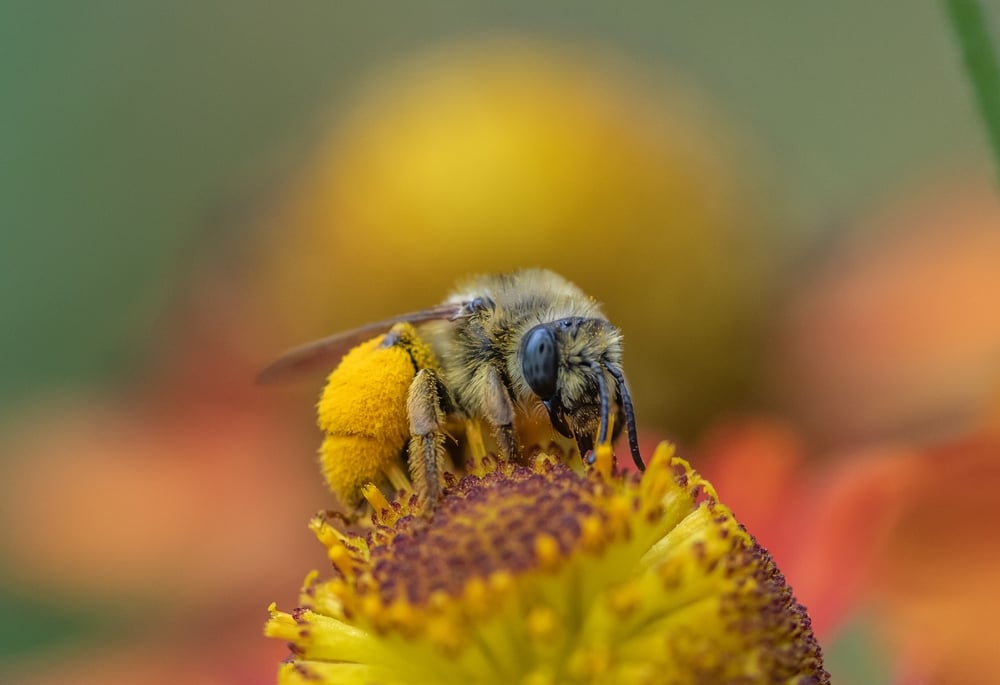
Identifying Characteristics and Facts
- Have varying colors and sizes.
- Mostly about 5 – 20 mm in length.
- Have elongated antennae – about 2 – 3 times the body size.
- Found in different habitats be it meadows, gardens, and lawns.
- They are solitary and do not live in colonies.
Did you know that there are over 200 species of long-horned bees? Of course, this is one family with several species and diverse characteristics.
These bees are predominant in Louisiana and in most other areas across the world. Most of the longhorn bees’ species have some specific types of plants that they pollinate. Therefore, they are great for promoting pollination and reproduction.
It is also worth for you to note that since the long-horned bees come in a variety of species, they thus have varying colors and sizes.
The reason behind the name ‘long-horned bees’ is the long antennae. They have about two to three times longer antennae than their body size. In addition to that, they play an important ecological role in pollination and reproduction.
Of course, these are just some of the common bees in Louisiana that I have captured. You will realize that most types also have hundreds of species with varying characteristics.
We, therefore, may not exhaust discussing each one of them but the above are the most common ones you will easily find in Louisiana.
Common Factors of Large Bees in Louisiana
As a reminder, the below factors are common for large bees:
- Most bees are non-aggressive and will not sting you
- Bees either live in colonies or in solitude
- All bees are great pollinators and can help you have a better garden, while some can produce honey
- Bees are most active in Louisiana in late spring through early fall